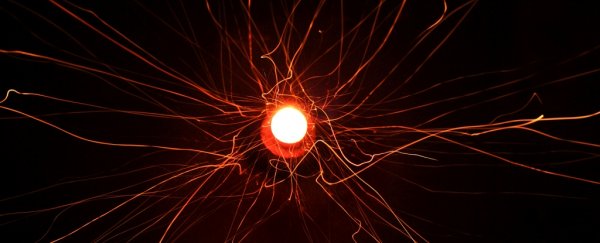Firing beams of neutrons at samples of silicon could lead us to an elusive, unknown 'fifth force' of nature, according to researchers.
Using a technique called pendellösung interferometry, a team of physicists led by Benjamin Heacock of the National Institute of Standards and Technology have used neutron beams to probe the crystal structure of silicon at the highest precision yet achieved, obtaining more detailed results than X-ray techniques.
This has revealed previously unrecognized properties in silicon, a material crucial to technology; more detailed information about the properties of the neutron; and placed important constraints on the fifth force, if it exists.
"Even though silicon is ubiquitous, we are still learning about its most basic properties," says physicist Albert Young of North Carolina State University.
"The neutron, because it has no charge, is excellent to use as a probe because it doesn't interact strongly with electrons inside the material. X-rays have some drawbacks when measuring atomic forces within a material due to their interaction with electrons."
Neutrons, found in atomic nuclei, are released during nuclear fission. These can be focused into beams that penetrate materials to depths much higher than can be achieved with X-rays, and are scattered by atomic nuclei, rather than atomic electrons, which means they can be used to probe materials in ways that complement X-ray measurements.
"One reason our measurements are so sensitive is that neutrons penetrate much deeper into the crystal than x-rays – a centimeter or more – and thus measure a much larger assembly of nuclei," says physicist Michael Huber of NIST.
"We have found evidence that the nuclei and electrons may not vibrate rigidly, as is commonly assumed. That shifts our understanding on how silicon atoms interact with one another inside a crystal lattice."
To do this, the particle beam is aimed at a material. Once the beam penetrates the material, the neutrons bounce and scatter off the structural lattice of atoms therein.
In a perfect silicon crystal, sheets of atoms in the lattice are arranged in planes that repeat in spacing and orientation. Bouncing the beam precisely off these planes can cause the neutrons to diverge in their routes through the lattice, generating faint interference patterns called pendellösung oscillations that reveal the structural properties of the crystal.
"Imagine two identical guitars," Huber said.
"Pluck them the same way, and as the strings vibrate, drive one down a road with speed bumps – that is, along the planes of atoms in the lattice – and drive the other down a road of the same length without the speed bumps – analogous to moving between the lattice planes.
"Comparing the sounds from both guitars tells us something about the speed bumps: how big they are, how smooth, and do they have interesting shapes?"
This technique yielded a new measurement of the charge radius in neutrons. Although neutrons are charge neutral, the three quark particles inside them are not. The up quark has a +2/3 charge, and each of the two down quarks has a -1/3 charge, which means overall they cancel each other out.
But inside the neutron, the charge is not evenly distributed. The positive charge concentrates in the center, and the negative around the edges; the distance between the two is called the charge radius.
Pendellösung interferometry isn't subject to the factors that have led to discrepancies between previous measurements using differing techniques, which means, the team said, that their result could be a key to narrowing down the size of this radius.
The technique is also able to provide more constraints on the as-yet undiscovered, theoretical short-range force. In nature, according to the Standard Model of physics, there are three forces, strong, weak, and electromagnetic. Gravity, not included in the Standard Model, is thought to be the fourth force.
To paraphrase Hamlet, however, there are almost certainly more things in heaven and Earth than we have described, and some physicists have proposed that there's an unknown fifth force that could explain anomalous observations. If it exists, then it may have a force carrier, in the same way that photons are the force carrier for electromagnetism.
The length scale over which a force carrier can act is inversely proportional to its mass. The photon, which is massless, has a limitless range. Pendellösung interferometry can provide constraints on range of the fifth force carrier, which in turn can place limits on its strength.
The team's results have constrained the range of the fifth force carrier tenfold, which means future searches for the fifth force have a smaller range in which to look.
"The great thing about this work is not only the precision – we can hone in on specific observables in the crystal – but also that we can do it with a tabletop experiment, not a large collider," Young said.
"Making these small-scale, precise measurements could make progress on some of the most challenging questions for fundamental physics."
The research has been published in Science.
